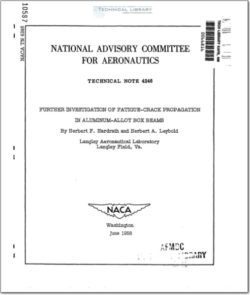NACA-TN-4246

- Version
- 195 Downloads
- 843.85 KB File Size
- 1 File Count
- December 4, 2015 Create Date
- December 4, 2015 Last Updated
National Advisory Committee for Aeronautics, Technical Notes - Further Investigation of Fatigue Crack Propagation in Aluminum Alloy Box Beams

Twenty-one box beams constructed according to nine designs were
subjected to fatigue tests at one load level to study fatigue-crack
propagation and accompanying stress redistribution. Six designs had
stiffeners riveted to the skin, two had integrally stiffened covers,
and one had stiffeners bonded to the skin. Specimens of each design
were constructed of 7075 aluminum alloy. Additional specimens of some’
of the designs were constructed of 202% aluminum.alloy. The rate of
crack propagation in specimens made of 7075 material was more rapid than
that in equivalent specimens made of 202% material. Specimens with
bonded stringers had lower rates of crack growth than any other speci-
mens tested. The most rapid rates of crack growth were found in speci—
mens having the smallest total stringer area and in specimens with inte-
grally stiffened covers.
One of the important design features of current aircraft structures
is the "fail—safe" characteristic. This feature is now receiving much
more attention than it did in the past to eliminate the danger of catas-
trophic failures which might be caused by fatigue cracks or accidental
damage.
The National Advisory Committee for Aeronautics is currently cons
ducting several investigations of the fail-safe characteristics of typi-
cal structural parts. Preliminary results of that part of this study
which applies particularly to the study of rate of fatigue—crack prop-
agation in wing structures have been presented in reference 1. The
results presented in that work indicated that the mode of connecting
stringers to the skin had an important influence on the rate of crack
propagation. Additional tests have been performed to investigate this
influence in more detail.
Two designs of box beams with rivet spacings one-half and twice
that used in reference 1 and one design with stringers bonded to the
skin were tested. In each of these designs the ratio of stringer area
At to skin area As was about 1.
Some current airplane wings have lower values of At/As than that
used in the riveted and bonded beams. 'In‘order to study configurations
representative of these wings, another series of tests was conducted on
specimens in which the amount of stringer material was reduced by one-
half. Three designs were tested to study various ways of arranging
the smaller stringer area.
| File | Action |
|---|---|
| naca-tn-4246.pdf | Download |

Comment On This Post